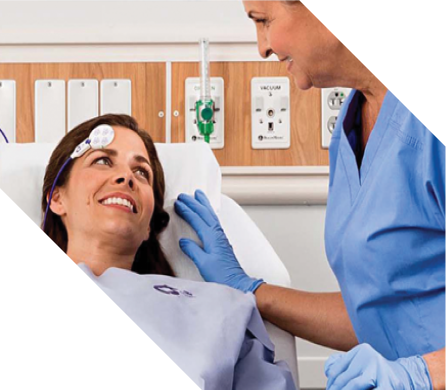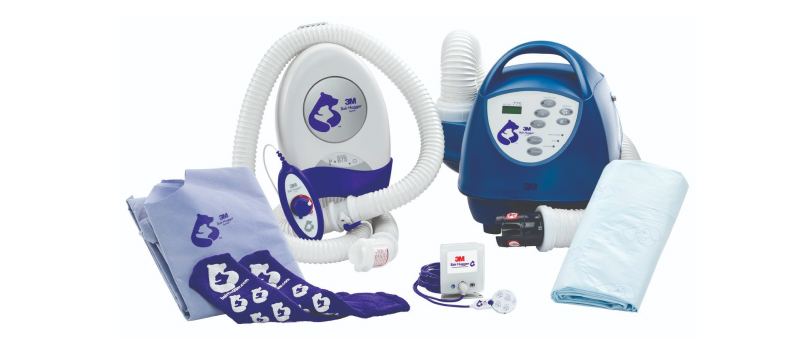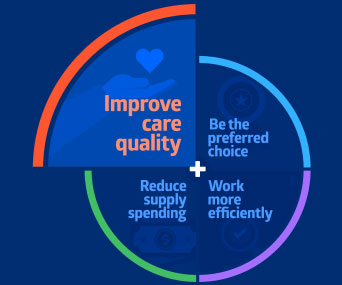
Insight
It’s not every day that you see competitors working together in the health care supply space. But as our relationship with 3M evolved into a more strategic one, and we looked at how we were serving customers in the normothermia space, we discovered partnership would drive better outcomes than competition.
“Synergy in the supply chain is critical, especially with body temperature,” explains Bret Hampton, US operating room solutions marketing manager for 3M’s Medical Solutions Division. “When you’re putting a warming gown on every single patient who’s going into surgery, you don’t want any interruptions in the process. You’ve got to be consistent every time.” This is where reduction in product variation and providing the essential education and training to ensure caregiver readiness is critical to optimizing operating performance.
To nurses, surgeons, medical techs and anesthesiologists, 3M’s temperature management products are a reliable way to warm millions of surgical patients each year. The fact that they have access to these products through a unique distribution partnership between Medline and 3M—gives clinicians one less thing to worry about when it comes to patient care.
“We aligned the two brands to say, ‘Let’s focus No. 1 on what’s best for the patient,’” recalls Jimmy Abrams of Medline. “It was groundbreaking for the industry, to say that. But 3M leadership was as committed to this strategic initiative as we were.” Abrams admits that the strategy is slightly non-traditional. But once the two companies committed to putting patients first, team members began to see the benefits of having a strategic, capable partner who could deliver innovative solutions for their customers, he says.
“It’s very easy for us in our role to say we are a distributor and the other players in healthcare are competitors, it’s why we’d want to limit their exposure with our customers,” Abrams says. “In truth, that’s bad. We need to make sure we’re thinking strategically in a way that is laser-focused on customers 100 percent of the time. Because at the end of the day if our customers do well and they serve their patients, we’ll all be stronger in the marketplace.”
Creating shared responsibility between manufacturer and distributor with a focus on the patient is why our partnership with 3M continues to work so well today. And the collaboration around 3M’s patient warming gowns is a prime example.
Challenges
- How can two competitors work together as supplier/distributor toward a common goal?
- Creating a normothermia standard of care for every patient, reducing post-op SSIs and com=plications is a complicated undertaking
Actions
Improve care quality:
Value-based care was a key consideration in developing standardization in product solutions, along with the right mix of communication and training
Results
Standardization around a Bair Hugger™ warming gown; 3M’s perioperative temperature management solution has four products; these, combined with patient education, protocols and other value-adds make up the full normothermia solution
“We’ve linked our salesforce at a local level to make sure that we are mutually focused on serving the customer, knowing that not every customer will choose Medline every time and not every customer will choose 3M every time, but that we will pursue best practices with customers, every time.”
Billy Abrams
President of Medline’s Distributed Products Division
Challenges
When providing solutions such as normothermia, it’s important to have a mindset of delivering value-based care, Hampton says. “Clinicians are asked to do a lot,” he says. “It’s a very challenging job with a significant amount of complexity and variables. You can’t solve for all of them, so you have to isolate the ones that will have the biggest impact on that patient’s outcome and then try to optimize for those and test them using science.” Keeping a patient normothermic throughout surgery is incredibly critical to having a positive outcome, and the science demonstrates that.
We understand, fast delivery of supplies just the way you need them is a crucial part of the healthcare supply chain, but providers must have the right clinical products to serve their patients. Our partnership with 3M shows just how effectively providers can operate when there is a true bridge between clinical expertise and supply chain efficiency. Standardizing around a Bair Hugger warming gown, for example, can help a facility reduce inventory, mitigate product loss, improve workflow, increase patient satisfaction and even drive down total cost of ownership for patient warming.
“A lot of customers will say, ‘I’ve got to buy all these gowns and blankets,” But you’ve got to pay a laundry service to clean them. You’ve got to pay for the electricity to run that warming units all the time. Where supply chain comes in—and what makes 3M unique—is that they take advantage of our expertise to help find a lot of that out. We will go in and evaluate that for the customer.”
Genell Walcott
Medline senior product manager
“It’s not just getting boxes to the right place at the right time,” Abrams adds. “That’s important, for sure, but it’s not sufficient. The much more critical element is that the Medline sales rep is educated and armed with best practices and information so we can help customers think larger and more globally about best practices.” This is just a small part of the value that we, as a healthcare distributor, can add to optimize patient outcomes.
For the warming challenges facing surgical patients, there are ways in which we, as a supply chain distribution partner, play an important role in supporting 3M’s goals. Step one is to ask proactive questions to uncover ways to improve utilization and workflow. We then seek to align needs with 3M’s goals to reduce unintended perioperative hypothermia.
Medline
How many blankets are used?
Is the right stock coming in?
Is it beneficial to switch to a different warming blanket?
3M
Enhancing quality of care
Streamlining workflow
Improving product standardization
Strengthening patient satisfaction
Actions
Maintaining normothermia through product innovation and supply chain expertise
Many variables contribute to the prevention of surgical site infections (SSIs). But one of the most critical is normothermia—maintaining a patient’s normal body temperature. Numerous studies show that a hypothermic surgical patient (defined as having a core body temperature less than 96.8 degrees Fahrenheit) is more at risk, not only for post-operative SSIs, but also other serious complications.
3M’s perioperative temperature management solution for normothermia—consisting of patient warming products, educational tools and resources—is at the center of the manufacturer’s SSI risk-reduction platform.
3M’s perioperative temperature management solution has four components:
- Bair Hugger™ warming gowns
- Bair Hugger blankets
- The Bair Hugger temperature monitoring system
- The Ranger™ blood fluid warming system

The offering has been a perfect fit for what we can then bring to the market as a healthcare distributor. “We manufacture products that go beyond a typical widget,” Hampton explains. “So, it’s not just a product by itself, but a product that comes along with education, on-time and in-full delivery, assessments and more. All those pieces make a real solution.”
Whether it’s managing par levels or helping capture user demand, our expertise in healthcare distribution enables 3M to focus on what it does best: manufacturing and implementing its temperature management solution for customers.
Addressing the use of cotton blankets for patient warming
Warming technique: Facilities are using up to 8 blankets on a patient to warm them.
Reason: Cotton blankets are deemed to be inexpensive.
Reality: If you have 7 or 8 that have to go to the laundry, get cleaned and come back, it’s very inefficient from a supply chain perspective in terms of standardization, SKU reduction and general process in the facility.
Further insight: Using cotton blankets isn’t actually efficient in keeping patients normothermic during and after surgery.
“The patient who has two blankets put on them is going to start to cool off, so the care provider must keep going and checkingon that patient, who may or may not realize theey’re getting cold,” Greg Hylton, vice president of vendor relations at Medline explains, “so you need to pull two more blankets that go on top of the others. This is very inefficient from a staff perspective, and clinically not superior, because you can’t regulate body temperature with a cotton blanket that’s going to cool off.”
Solution: Medline and 3M identify opportunities to standardize from 7 or 8 cotton blankets to a single Bair Hugger warming gown, which can actively transfer heat to the patient perioperatively and postoperatively, along with maybe only 1 or 2 cotton blankets if needed.
A true partnership requires getting on the same page with the sales force
When we started working with 3M to further align our manufacturer-distributor relationship around patient outcomes, a big part of that alignment carried through to the sales force. So, how can two traditional competitors work together in some areas and compete in others?
“It’s very much experience driven,” explains Billy Abrams, president of Medline’s Distributed Products Division. “If you think you have a competitor, you treat the other rep as a competitor. Once you realize you have a potentially ally, that changes. It has to happen at the top of the organization, but then it has to happen tactically.”
Leaders started by asking sales reps to go get coffee together, a practice that continues today. To encourage sales reps to build those relationships, Abrams will often send them Starbucks gift cards.
With respect to the science of normothermia, both companies actively share this science with their sales reps, who can then share it with clinical end users. Our sales reps are trained to understand the value of normothermia, the risks of recovery and infection prevention, and how various products help regulate temperature during surgeries. And as codes change and guidelines change, they also stay updated on those changes and know who to talk to about any clinical issues that impact patients.
“We want our reps to know why our customers are going to want to buy the product,” says Genell Walcott, a Medline senior product manager. “It’s not just because you as rep are going to make money and they are going to save money. It’s important for you as a supply chain partner to help them make the right decisions to drive better outcomes. We go beyond the ‘feature-benefit’ approach. We want our reps to understand the science, so they can help 3M drive that science.”
Evaluating the science
Several years ago, 3M developed and launched its own Enhanced Recovery After Surgery (ERAS)-compliant perioperative normothermia protocol with clinical best practices for patient warming from pre-op through to the Post-Anesthesia Care Unit (PACU). The company also created a Bair Hugger research compendium that contains more than 170+ studies and papers related to patient warming. This wealth of data helps strengthen patient satisfaction before surgery and sets them up for a good outcome.
Results
Our collaboration may be unique, but by prioritizing patient outcomes, our mutual customers reap the benefits. “These strategic partnerships allow us to see our customers better because we end up focusing on best practices and outcomes — not product,” Medline’s Abrams says. “When that happens, it becomes magical because our customers actually do better. They provide better care. And customers who provide better care do better in the marketplace and end up being long-term customers of the business. That’s actually what we’re striving for.” We’re both committed to making healthcare better, more effective and less expensive when possible, and ultimately, to improve patient outcomes. Moreover, neither company takes their special partnership for granted.
“If we ensure that we’re doing our job on the manufacturing side with high-quality products, that we’re educating our customers, and that our customers have the products they need when they need it, then we’re all tracking toward the same thing: Better outcomes for our patients and driving toward zero complications.”
Bret Hampton
U.S. OR solutions marketing manager for 3M’s Medical Solutions Division
From 3M’s perspective, they also reiterate how well the companies’ core competencies fit together, especially in normothermia. Medline has been a tremendous distribution partner not only by ensuring minimal disruption in the supply chain, but also by helping 3M improve outcomes through patient warming.
“That’s the synergy of us and Medline,” Hampton says. “It all comes back to, ‘How can we help our clinicians? How can we help our providers? And how can we truly help patients have a better outcome?’ That’s the ‘why’ behind everything. And then from there, everything follows: Quality of care, workflow, patient satisfaction. Those are outcomes. If we can look at those four things, then we can break those down into real problems that we can solve.”


